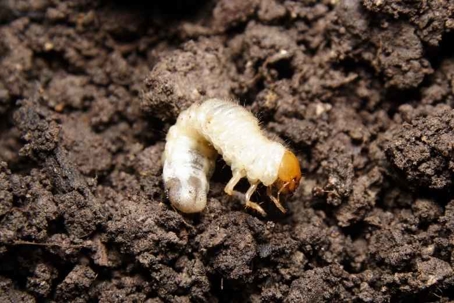What Do Grubs Eat?
Grubs are the larval stage of various beetles, including Japanese beetles, June beetles, and European chafers. Their diet primarily consists of organic matter in the soil, but more specifically, they feed on plant roots, which is why they are notorious for damaging lawns, gardens, and crops. Grass roots are a particular favorite, but they will also consume the roots of vegetables, flowers, and ornamental plants.
Some species may also feed on decaying plant material in the soil, but healthy, living roots are generally preferred. The damage they cause often appears as patches of wilting or browning grass, because the grubs sever the roots and reduce the plant’s ability to absorb water and nutrients.
Environmental factors like soil moisture and temperature can influence their feeding activity. Moist, well-watered soils encourage grubs to feed near the surface, while dry conditions may drive them deeper. Controlling grub populations typically involves monitoring for larvae in the soil and applying targeted treatments during their most vulnerable stages.
Do Grubs Eat Plants?
Yes, grubs do eat plants, but not the above-ground parts like leaves or stems—they feed primarily on plant roots. This root feeding can seriously damage lawns, gardens, and ornamental plants. By chewing through roots, grubs reduce a plant’s ability to absorb water and nutrients, often causing grass to wilt, turn brown, or pull up easily.
Different species have slightly different preferences:
Japanese beetle and European chafer grubs mainly target grass roots.
June beetle grubs can feed on a wider range of plant roots, including vegetables and ornamental plants.
Some grubs will also feed on decaying organic matter in the soil, but living roots are their main food source.
The damage is usually more severe in well-watered, lush lawns, because the roots are tender and accessible. In a pest management context, identifying grub presence early is key to preventing widespread plant stress or death.
Do Grubs Eat Grass?
Yes, grubs definitely eat grass, specifically the roots of grass plants. This is why they are a major problem for lawns. By feeding on roots, grubs weaken the grass, making it unable to take up water and nutrients properly. The visible signs of grub damage often include:
Brown or yellow patches in the lawn that may expand over time.
Grass that pulls up easily, as the roots have been chewed through.
Areas that may attract animals like birds, skunks, or raccoons, which dig to eat the grubs.
The most common lawn-damaging grubs come from beetle species like Japanese beetles, European chafers, and June beetles. They tend to feed near the soil surface, especially in moist, well-irrigated lawns, which makes such areas particularly vulnerable.
Managing grubs usually involves monitoring grub populations in the soil and using targeted treatments at the appropriate time in their lifecycle, often late summer or early fall for most species.
Do Grubs Eat Dead Plants?
Yes, many grubs will eat decaying plant material, although their primary food is usually living plant roots. Feeding on decaying matter is more common in certain species or when young grubs are small and establishing themselves in the soil. This type of feeding can help them survive in soil that has limited access to fresh roots, but it generally causes less damage to plants than root feeding.
Grubs such as Japanese beetle and European chafer larvae prefer grass and other living roots, but they can supplement their diet with decaying organic matter. Feeding on decaying matter may help grubs develop in soils rich in compost or organic debris, giving them a foothold until they can reach live roots. While decaying plant material is edible, the most noticeable lawn and garden damage comes from roots being eaten.
Do Grubs Eat Insects?
No, grubs generally do not eat other insects. Most grubs are herbivorous, feeding primarily on roots of plants, grass, and sometimes decaying organic matter. They are adapted to a diet of soil-based vegetation rather than being predatory.
There are exceptions in the broader beetle larval world—some beetle larvae (like certain ground beetles or ladybug larvae) are predatory and do eat insects—but the common lawn or garden grubs from species like Japanese beetles, June beetles, or European chafers are strictly plant feeders. Their “damage” comes from eating roots, not from preying on other soil insects.

